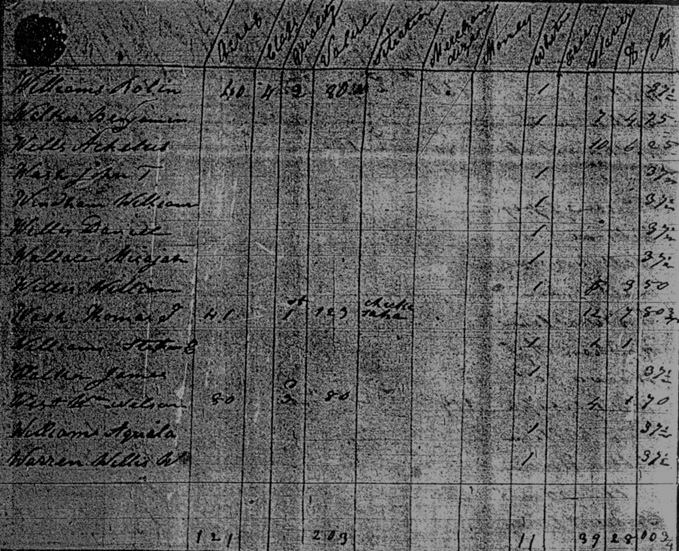7 July 2014

The debate continues. When we use an image copy, do we consider that to be an original or a derivative?
As with all other aspects of research, it depends—which means it is a judgment call we make on the basis of a thoughtful evaluation of what we're using. That judgment is a lot more meaningful than a label.
Today's images, taken from successive pages of a microfilm tax roll, demonstrate the folly of applying any one-size-fits-all label.
EE 1.26 offers this advice:
"Image copies are typically defined as photographic reproductions made digitally or on film. Theoretically, they are the equivalent of an original. However, they may or may not be of equal merit.

"Modern history researchers rely heavily upon microform and digital images, not only for long-distance access but also to preserve the fragile originals. Yet any image copy can present problems.
"Imagers may have missed a page of a register or a loose document from a file. They may have had difficulty filming text in the crack of a record book. Lighting conditions might have produced inferior copies. Moreover, the black-and-white medium long used for image copies can mask content problems that are visible on the original, such as erasures in a record and alterations or additions in a different color or type. Photocopies made by other researchers also may have been altered to provide evidence for one purpose or another.
"As history researchers, we are justified in treating image copies as originals so long as
- the images are legible; and
- their information does not conflict with other evidence.
"In case of conflicts or poor legibility, we should treat the image copy as a derivative and seek access to the material from which the images were made."
Other fundamentals of evidence analysis are accessible in the "Sample Text Pages" module of this website.
IMAGE SOURCE: Photocopies made from Newton County, Mississippi, 1840 Combination Tax Roll, unnumbered pages; MDAH microfilm 5088; imaged from Record Group 29, Auditor of Public Accounts, Mississippi Department of Archives and History, Jackson.
Poor image quality
When I download an image from a microfilmed copy of a document--be it a census, death record, or military pension file document--I upload it to Picasa and tweek it so it's aligned, the lighting is favorable, and the contrast is right for making print crisp. Wouldn't this be considered an original, since all I did was enhance the legibility?
Tweaking images
Interesting question, Debra! It's also an issue that our online providers have to deal with regularly.
If we accept the premise that a responsibly prepared image is the equivalent of an otherwise unaccessible original, then we should also accept the premise that adjustments of the type you describe, to enhance legibility, do not devalue the credibility of the image.
As a side issue: If we perform these enhancements while our citation simply credits an online provider, then others who use that provider will not get the same quality image. Something that might be legible on our lighting-enhanced image might not be legible on the image the other person is viewing. As a consequence, our readers might reasonably question our assertion that the image says what we attribute to it. For that reason, many researchers prefer to add a statement to their citation that says something to this effect: "image enhanced using Picasa lighting and contrast settings to increase legibility; none of the document's content has been altered."
Tweaking Images
I am a little OCD & tend to "Tweak" Images of documents and also photos.
In addition to adding a statement to a source citation indicating the image was enhanced (specifying the way in which altered) as the EE Editor explained, I personally have found it extremely useful to also keep a copy of the image as it was BEFORE any adjustments. I indicate not only that I have enhanced the image but that upon request I also can provide a copy of the image as it was before I made any adjustments.
I learned the hard way that even just "minor" adjustments to make an image clearer can at times inadvertently remove useful information.
For instance, once using lighting & contrast adjustments on a census image I accidentally removed a small mark that was purposefully put there by the census taker yet was so light that a slight adjustment to the lighting caused the mark to disappear. Luckily I caught my mistake however it made me realize how easy it is to accidentally remove important information.
This also happens frequently when enhancing images of damaged photos. Once while removing creases and lines caused by damage to a photo I realized after reading a story about the person in the photo that she was once abducted by Indians and given a tattoo on her chin. The tattoo was two small lines. Those lines looked to me initially to be part of the damage to the photo as there were scratches on the photo in the same area that looked extremely similar. Had I not researched her history and had kept the "original" in addition to my "enhanced" photo, important historical evidence backing up her story would have been lost.
The moral of my story is to (1) be extremely careful when "enhancing" images (2) include a statement describing ANY adjustments made (3) always adjust a copy & keep a copy of the unedited version.